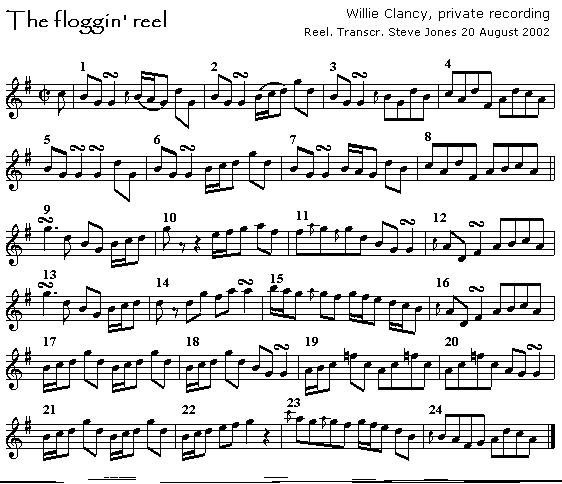A brief analysis by Steve Jones, 20 August 2002
This clip is of a private recording supplied by Peter Laban. Some biographical notes on Willie Clancy by Peter can be found on the tune index page (follow the link above).
The tune is played twice through on a high F whistle. As Peter noted in his comments on The maid on the green, Willie's playing exudes a tremendous liveliness and vitality. For all its energy and drive it remains somehow playful.
Listening to this clip of Willie one realizes how much of an influence his exuberant and driving style has had on that of Mary Bergin and, through her, on vast numbers of today's fine whistlers.
The floggin' reel is a well-known tune, something of a showpiece for soloists. Modern performances, including this one, differ little from the setting published by O'Neill in The Dance Music of Ireland.
Although I have transcribed (in this first version, anyway) only the first playing of the tune, there are many variations in the second playing, and I shall try to point out the most notable of these. I found this quite a challenging tune to set down on paper, and of course the usual caveat applies, i.e. that the notation cannot give you everything.
I had to make some editorial choices, for example how to notate the descending cascades of what most people would call triplets in bars 15 and 23. These could have been shown as triplets proper, as groups of two sixteenth notes followed by one eighth note, or as two eighth notes preceded by a cut. I used a combination of the last two methods to try and get as close as possible to the feel of Willie's phrasing, although things might have looked simpler if I had used triplets throughout.

Bars 1, 2 and 3 all begin with a B-G offbeat roll figure, followed by a linking motif which is the same in bars 1 and 3 and inverted in bar 2. (On the second playing, in bar 1 we get a nice jolt from Willie's use of a c-natural in place of the d that begins the fourth beat.)
Bar 4 starts with a tricky little figure which (to my mind, at any rate) becomes easier to understand when you realize that it also features an inversion - if you drop the third note (high d) down an octave, the progression (although still an unusual variation on what we often hear in this part of the tune) becomes more conventional. Willie has given it an interesting twist by kicking the note up an octave.
Bars 5-7 are basically a repeat of bars 1-3, with some variations, including a short roll on G tacked onto the end of the off-beat roll in bar 5. Bar 8 uses the same inversion we saw in bar 4.
The second part of the tune (bars 9-16) can be seen as an echo of the first, an octave up. Bar 9 starts with a long roll on high g. Though we might expect bars 10 and 11 to follow suit, in fact in bar 10 we get an unexpected stop after an eighth note, followed by a massive intake of breath lasting the space of three eighth notes (the first time Willie has breathed since the tune began!). (In the second playing, Willie breathes in the first part of the tune, and perhaps as a result is able to handle this passage more conventionally.)
Then, in bar 11, we get a characteristic figure for which I have never known the name. Basically it is a long roll in which the first component is replaced by a lower note - in this case f# instead of g. The effect is similar to that of an upward slide into a long roll. Peter Laban tells me the term "rising roll" is used for this device, and it's as good a name as any. It looks rather ordinary on paper, but the effect on the ear is much more dramatic. In fact the notation is quite accurate.
In bar 12, and also in bar 16 there is a short roll on F#, preceded by a low D. In the second playing of the tune Willie resorts to a more conventional off-beat roll (AF~F2).The first beat of bar 14 provides a further surprising substitution for the long roll on g in the form of a short d, repeating the last note of the previous bar, followed by a breath.
Bar 15 is filled with the cascading downward runs I alluded to earlier. This is the best way I can render them.
The third part of the tune (bars 17 - 24) contains few surprises. Willie handles the high f-naturals in bars 19 and 20 with ease. He ends bar 22 with an abrupt quarter-note rest, providing a well-deserved breathing space as well as a moment of poise before the tune rushes into its final descending cascade.
The runs in bar 23 sound a little different to my ear than those in bar 15, hence the attempt to notate them differently.
In the second playing, apart from the differences already noted, the most notable change is that Willie takes most of his breaths in different places, which allows him to further vary the phrasing and avoid any hint of monotony - not that there is much danger of that here.
As always, I will be very grateful if readers point out any mistakes in my transcription or interpretation. There are bound to be some.
Steve Jones